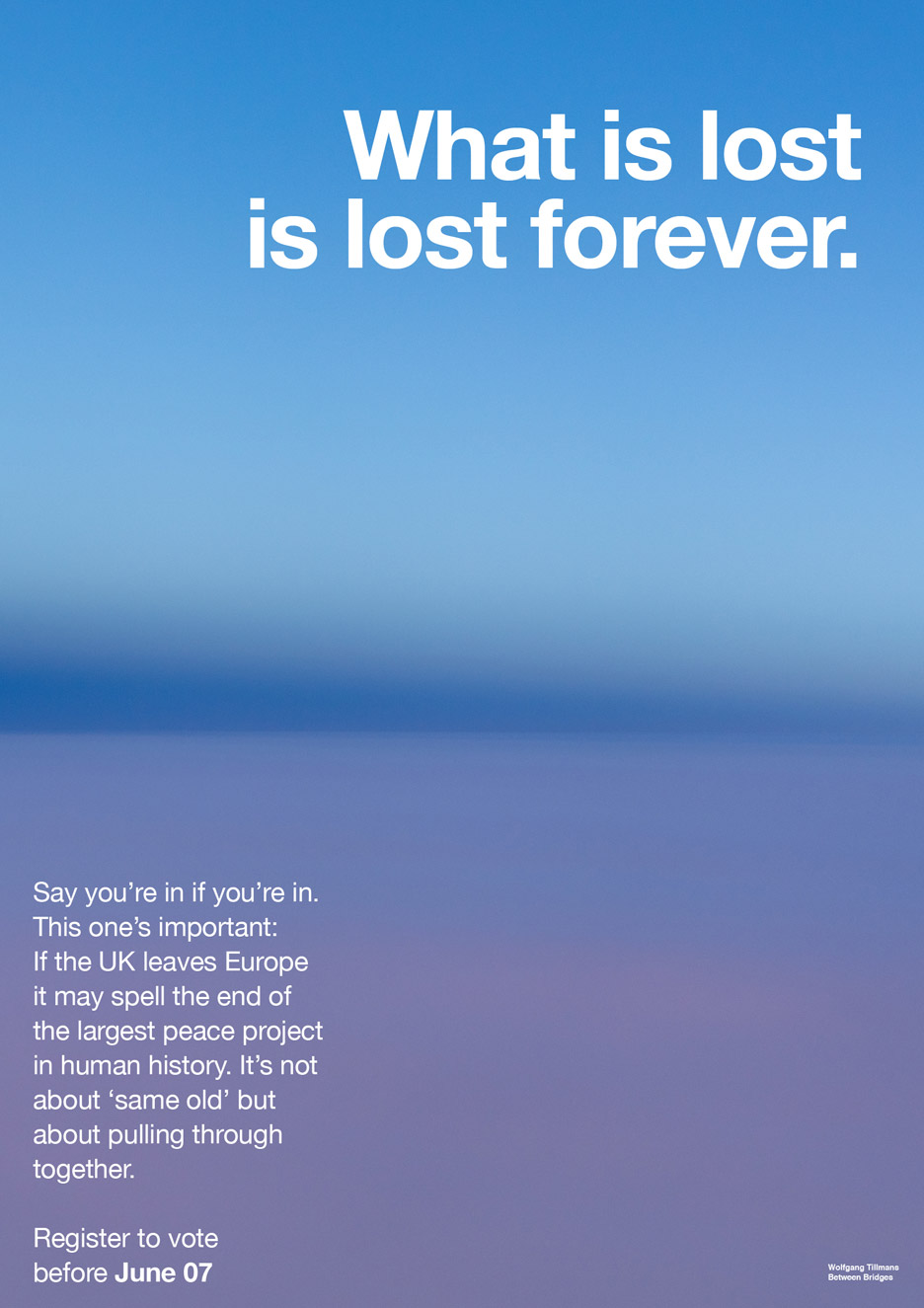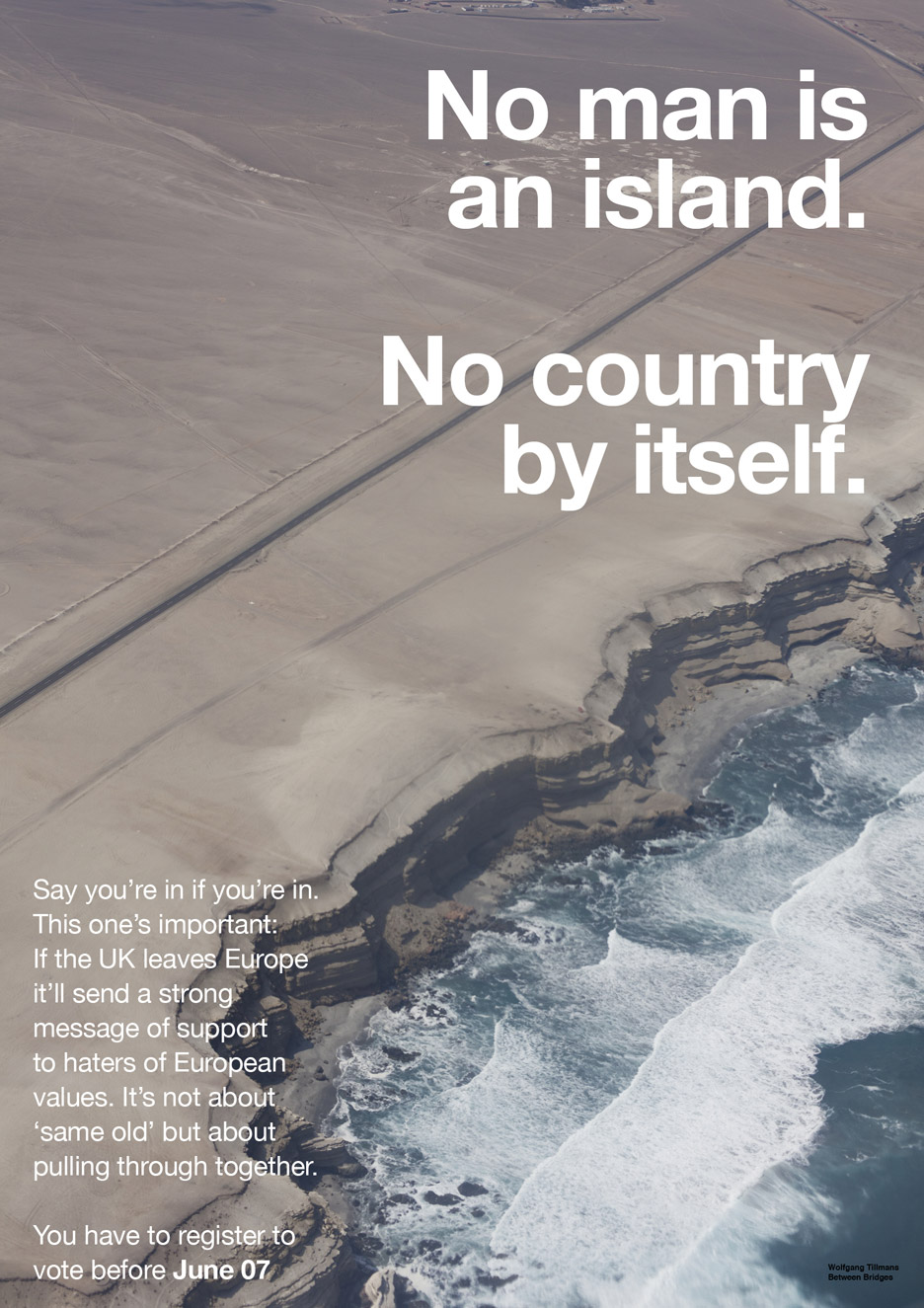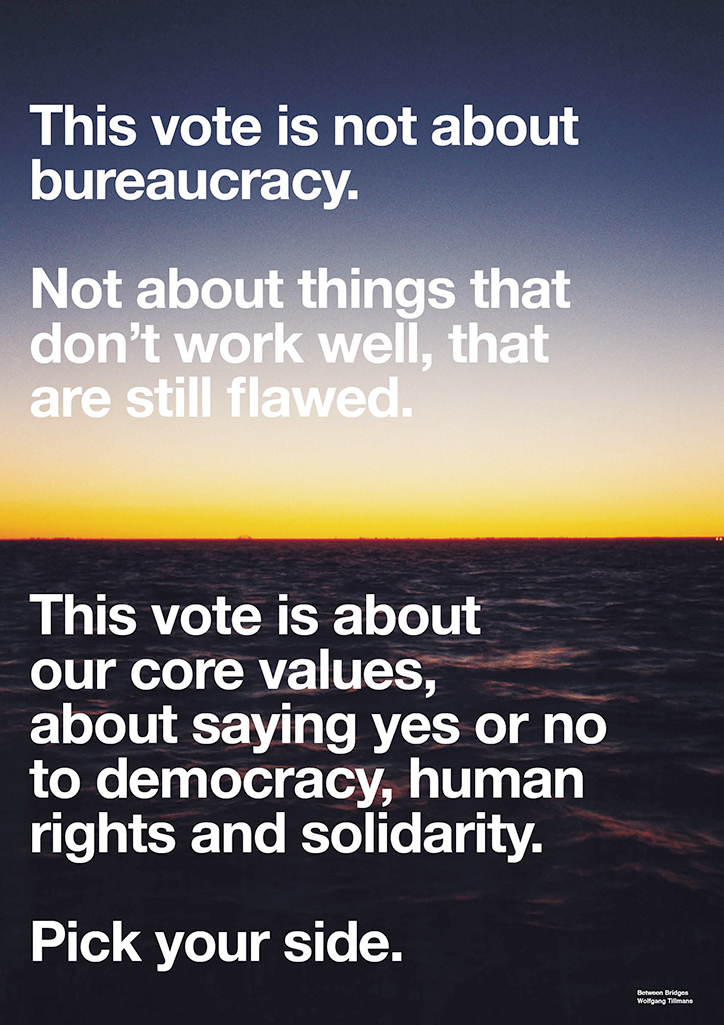 “What is lost is lost forever”. This heart-rending slogan is one of the most memorable of those used on Wolfgang Tillmans’s anti-Brexit posters, launched on 25 April 2016. With his emotive language and direct address to younger, internationally-minded voters, Tillmans struck a markedly different note from the official Remain campaign. His appeal was to the students, the young artists and the fellow creatives, as well as anyone who cares about the EU and the rights and freedom of movement it offers to its citizens. Some praised his smart appeal to a legion of young, digital-savvy followers, while others dismissed the poster campaign as short-sighted lecturing from the cultural elite.
“What is lost is lost forever”. This heart-rending slogan is one of the most memorable of those used on Wolfgang Tillmans’s anti-Brexit posters, launched on 25 April 2016. With his emotive language and direct address to younger, internationally-minded voters, Tillmans struck a markedly different note from the official Remain campaign. His appeal was to the students, the young artists and the fellow creatives, as well as anyone who cares about the EU and the rights and freedom of movement it offers to its citizens. Some praised his smart appeal to a legion of young, digital-savvy followers, while others dismissed the poster campaign as short-sighted lecturing from the cultural elite.
It is a poignant, almost jarring moment to revisit these images, just two days after the UK was due to officially leave the EU on 29 March. This has now been delayed to 12 April, with still no clear solution in sight. Two years after the referendum, and following a bitter (and ongoing) fight between the two sides, Tillmans’s campaign inevitably strikes a difficult, anachronistic note. Some of his posters put forward sentiments that in hindsight come across as blithely optimistic; one reads, “My father’s English, my mum’s French, I studied in Vienna, I now live in Denmark. It’s never been a hassle to do so. And I don’t want it to be.” Others offer up broader reflections, paraphrasing the poet John Donne’s well-worn words, “No man is an island. No country by itself.”

“They reveal a keen understanding of branding and visual communication in the digital age“
His posters, featuring a modern, stripped-back sans-serif text, were offered open-source online with the aim of encouraging more people to register to vote, with one download pack optimized especially for sharing on social media. They reveal a keen understanding of branding and visual communication in the digital age—the New Yorker announced the campaign with the headline “The Artist Who Wants to Make the E.U. Sexy”—but fall short in their ultimate failure to appeal beyond a narrow group of like-minded individuals. It is a criticism that was leveraged at London in particular in the wake of the vote.
Tillmans argued in a letter published alongside the posters that, “The reasons why I felt compelled to get involved in the UK-EU referendum are personal—my lifelong involvement with the UK, my love for the UK and its culture, music and people, my career’s groundedness in Britain and the always warm welcome I felt here as a German. I see myself as a product of the European post-war history of reconciliation, peace and exchange.” In the time that has passed since he wrote these words, it has been made clearer than ever before that the personal has become the political. The family dinner table is now the battleground for a Leave-voting aunt to pit herself against a Remain-fervent teenager. And what hope is there for our own resolution when the government are no closer to reaching one themselves?
Tillmans’s campaign also raises a wider question around whether artists, and other figures in the cultural and creative industries, ought to weigh in on political matters at all. His own photographs were repurposed for the campaign; they are evocative, hazy images taken from plane windows, or else looking out across the open water at a distant horizon. While he did assert that anyone could “take my name tag off if more appropriate”, the posters in their original form bore the Tillmans insignia and, for anyone familiar with his photography, are visually recognisable as his. How far did the combination of the two blur the line between personal interests and political campaign?

“The campaign also raises a wider question around whether artists ought to weigh in on political matters at all“
Just this week, Jeremy Deller launched a new artwork that reads, simply, “Farage in Prison”. Inscribed in a familiar plain sans black text on a baby pink background, it builds on a theme made clear in his “Strong and stable my arse” posters, as well as the “Fuck Brexit” t-shirts that he released last year. Like Tillmans, Deller is able to leverage the platform that he is afforded as a cultural figure to speak directly to one of the most pressing political moments in recent British history. The two are hardly alone in their thinking. Hundreds of thousands marched last weekend in support of EU membership, and a petition calling for article 50 to be revoked, reversing Brexit, secured six million signatures in ten days.
In 2017, the Design Museum nominated Tillmans’s Remain campaign for its Designs of the Year prize, alongside a number of other politically-minded projects. It was also exhibited at Photo London in the same year. But it is difficult to ascertain just how far campaigns like this are able to travel beyond the worlds of art and design and, crucially, how far they are able to reach voters beyond the London bubble. Britain remains a country more divided than ever before, with little relief or reconciliation ahead. Tillmans may have set out to bring people together, but his sentiments also serve to highlight just how great the differences between us really are. As he wrote in 2016 with the release of this campaign, “Let’s hope for the best—but hope may not be enough”.





